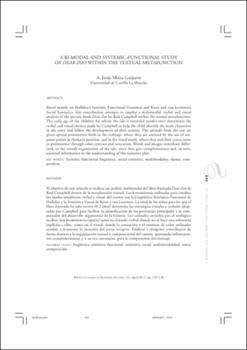A Bi-modal and Systemic-Functional Study of Dear Zoo within the Textual Metafunction
Fecha
2011Resumen
Based mainly on Halliday’s Systemic Functional Grammar and Kress and van Leeuwen’s Social Semiotics, this contribution attempts to employ a multimodal, verbal and visual analysis of the picture book Dear Zoo by Rod Campbell within the textual metafunction. The early age of the children for whom the tale is intended (under-two) determines the verbal and visual choices made by Campbell to help the child identify the main characters in the story and follow the development of their actions. The animals from the zoo are given special prominence both in the verbiage, where they are omitted by the use of suspense points in rhematic position, and in the visual mode, where they and their crates come to prominence through color contrast and saturation. Words and images contribute differently to the overall organization of the tale, since they give complementary and, in turn, essential information to the understanding of the narrative plot. El objetivo de este artículo es realizar un análisis multimodal del libro ilustrado Dear Zoo de
Rod Campbell dentro de la metafunción textual. Las herramientas utilizadas para estudiar
los modos semióticos, verbal y visual, del cuento son la Lingüística Sistémico-Funcional de
Halliday y la Semiótica Visual de Kress y van Leeuwen. La edad de los niños para los que el
libro ilustrado ha sido escrito (0-2 años) determina las estrategias visuales y verbales adoptadas por Campbell para facilitar la identificación de los personajes principales y la comprensión del desarrollo argumental de la historia. Los animales enviados por el zoológico
reciben una prominencia especial tanto en el modo verbal, donde no se hace una referencia
explícita a ellos, como en el visual, donde la saturación y el contrate de color utilizados
ayudan a mantener la atención del joven receptor. Palabras e imágenes contribuyen de
forma distinta a la organización textual y composicional del cuento, aportando informaciones complementarias y, a su vez, necesarias, para la comprensión del mensaje





